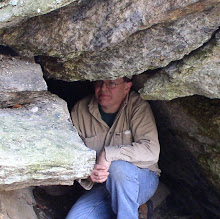Two weeks short of a year, the time has arrived to put together a multi day trip. Unless, one wants to include a lengthy stay in the hospital as an example of 'Grand Adventure'.
Balance Rock from a postcard a few decades ago
But I picked up - where I left off last year - setting my sights upon eventually arriving in Cape Ann. But first things first, as I made my way through two Middlesex County towns/cities. Stop #1 involved looking up the site of a couple old soapstone mine, now more of water-filled ponds. Several miles to the southeast found a splendid example of a balance rock.
The 'pot hole' @ Shaker Glen from an old Magic Lantern Slide
The 'pot hole': present day
Even further to the southeast, beginning to reach the Boston suburbs at Woburn, were two examples of Indian Bowls. These formations are more natural and really examples of pot holes.
The Old Man of Joppa; early 1900's postcard
The second day was an all Cape Ann day, looking into sites on this island/peninsula. Up first was a revisit to an area that seems to be the final outcome of the Old Man of Joppa search. The years have definitely obscured the formation with construction and vegetation growth. However, a local person of knowledge, has defined it as this location. It is one that caught my eye many times during my travels through the area,a very prominent, very high, ridge of rock. The perspective depicted in the old postcard is not entirely clear as to how big this ridge actually is.
Sea Rocks and the boulder cave
Moving on up to the northern tip of Cape Ann, the Sea Rocks property provided some massive sized boulders with caves underneath. Slightly further south, I scouted out the former location of a plaque, on a boulder, dedicated to Ralph Waldo Emerson. My walk along the coast began at Chapin's Gully, took me past the Great Gargoyle, Blue-Quartz dike, and ended up by the Frog.
The Great Gargoyle - circa 1915 to 1930
This particular day was finished by a visit to the rocky summit of Poles Hill and a 'secret cave' upon Cape Ann.
Appleton's boulder
On day three, it was time to leave my 'island home' behind if only temporarily. Chugging along the old highway east, my first goal was a farm. Not any old farm, but one with a plaque on a magnificent boulder, dedicated to early settler Samuel Appleton.
Continuing along the highway a bit to the northwest, I finally (after many years) got to look at an old lead from the John Henry Sears' geology book on Essex County: Metcalf Rock. The name (further research needed) has lent itself to an old smallpox cemetery in the region. I believe - at least at this point - Metcalf Rock may be a somewhat broad area of rocky outcrops. Although one major, flat topped rock, was encountered right about at the location designated by Sears on his geologic map.
Cradle Rock- circa 1900
And still further west I dropped into the local library to try and dig up information on another vague JH Sears reference to a Mineral Paint Mine. Little success to be had on this one - or trying to find legitimate access to the nearby Cradle Rock. This long lost rock has finally turned up on a map, but apparently rests way back in someone's private back yard.
Sliding Rock
Breaking camp on the fourth day, it was time to head on home. But not before furthering my explorations in Middlesex and Essex County. I started the morning at Indian Cave, hoping for an improvement over the photos of last Spring. Then wandered down to the Lynn shoreline, where the partially receding tide allowed me access to a couple boulders. The first, I attempted to match with an old photograph but was not totally successful. A short walk north brought me to the much better know Sliding (or - Slippery Sliding) Rock. Best know (but not visited this time around) is Red Rock, just a short jaunt to the north. The tide was not quite far enough out to allow me access to the Cliff Cradle a short distance north in Swampscott.
Leaving Essex County behind, it was time to head on west to look into Prospect Hill Park and its rocks. The final stops were just north, in Lexington, where three erratic sites were checked, one not being found. An old paint mine was visited in-between the Lexington boulder investigations.
And Home - via the Mohawk Trail!












































